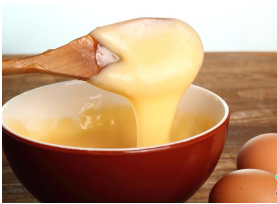You are preparing homemade mayonnaise and when you are in the process, it cuts! But what happened? Do not despair or discard the mixture because it has a solution and it is very simple. we reveal why mayonnaise cuts and how you can easily repair it. In addition, you will learn other secrets of this famous traditional sauce to learn how to make mayonnaise without cutting it. We assure you that after reading this article you will be an ace preparing mayonnaise and…, repairing it.
 A cut mayonnaise can spoil our food especially if we have decided to prepare it at the last minute. However, everything has a solution! Discover with us how to fix a cut mayonnaise and stop worrying about this incident.
A cut mayonnaise can spoil our food especially if we have decided to prepare it at the last minute. However, everything has a solution! Discover with us how to fix a cut mayonnaise and stop worrying about this incident.
Why cut the mayonnaise?
We could almost guarantee that most of the people who have made homemade mayonnaise have come across this situation, at least once. Perhaps the worst thing about something going wrong in the kitchen is not only the loss of the ingredients and the preparation itself, but also the uncertainty of what went wrong. Well, this will no longer happen to you with cut mayonnaise, since below we reveal the most common causes that can explain why mayonnaise is cut:
- Excess fat in the preparation. This is the most common mistake and it happens if the portion of oil exceeds the amount of egg. When this occurs, the emulsion breaks down. Visually, you will find a liquid and lumpy mixture with balls of fat. In this way, if the mayonnaise is very liquid and, in addition, it presents these little balls, here is the reason.
- Too much oil at first. If you rush to add plenty of oil from the start, you slow down the emulsifying ability of the egg as it mixes with the oil. The ideal is to add the fat little by little until you get the emulsion, then you can pour a larger portion of this ingredient.
- Low quality products. A good ingredient does not imply that it is very expensive, but it must be very fresh, show a good appearance (without abuse) and follow certain standards.
- Very cold or very hot ingredients. Ingredients should be at room temperature to speed up the “transfer of emulsifiers from yolk particles to fat droplet surfaces,” in the words of food chemist.
- Use of complex methods if you are a novice. If you are learning to prepare homemade mayonnaise, the best thing to do is to apply the easiest technique. The most recommended, at first, is to put all the ingredients in the blender except the oil, mix at medium speed if it is a blender or low speed if it is an immersion blender and gradually add the oil, in the form of a thread and…, clever!
- Beat at high speed and/or move the mixture to all sides before it emulsifies. If you beat with an immersion blender, do it at minimum speed until it emulsifies and without stopping (for about a minute). At first, leave the artifact submerged in the same position until the preparation begins to emulsify. Then, go up and down, little by little, until you cover all the areas and get a homogeneous mixture. Instead, if you prepare the mayonnaise in the blender, use the constant medium speed without stopping.
- Using inappropriate amounts of ingredients. Ideally, one third of the rest of the mixed ingredients should be used for each volume of oil. This recipe in specific quantities would be as follows: 1 egg of 60 grams (or 2 yolks), 160 ml of oil, and 5 grams of lemon juice and 3 grams of salt.
- Add additional ingredients before emulsifying the mixture. If you are making a gourmet mayonnaise, it is best to add the extra ingredient after emulsifying the preparation, at least until you gain more experience with this type of recipe.
How to recover a cut mayonnaise?
You already know the possible causes that justify why the mayonnaise is cut, but can you fix a cut mayonnaise? First of all, stress out! If your mayonnaise has been cut, the solution is not to throw it away; you simply have to recover it, since it is not a product in poor condition, but a sauce with an error in its preparation. In this way, if you wonder if a cut mayonnaise can be eaten, the answer is yes, but you have to fix it first. Do not be discouraged, if it is your first time and this happens to you or if it has happened to you on several occasions, be encouraged by thinking that even great chefs sometimes cut their mayonnaise. So let’s get to work and put the solution to the problem. To do this, we show the most effective and infallible methods according to experts to recover different types of mayonnaise.
How to recover a mayonnaise cut with water?
This trick is really effective in saving an egg cut mayonnaise. Pour two tablespoons of warm water into the blender, blend it and slowly add the mayonnaise cut into threads. Apply low speed and wait until it emulsifies again. If you want to thicken it a little more, only after seeing that it recovers the right texture, you can add a little more oil (one or two tablespoons), very slowly and also in the form of a thread. If this method doesn’t work for you, you can still apply the next one.
How to fix a mayonnaise cut with egg?
Adding an egg at room temperature is another of the tricks to fix a cut mayonnaise. In this case, place the egg in the blender and pour the mayonnaise cut in doses, letting it fall in the form of a thread.
How to recover a mayonnaise cut from milk?
To make the most of a curdled milk mayonnaise, it is best to add a little warm milk. Thus, pour a tablespoon of milk into the blender glass and foam it. From that moment, slowly pour, in the form of a thread, the cut lactones. Use medium speed and wait until it acquires a new body.
How to fix a mayonnaise cut without egg (vegan)?
If you’ve made a vegan mayonnaise and its cut, you can fix that too! Pour 4 tablespoons of the cut vegans into the blender glass and beat at medium speed while adding a very fine thread of oil. Wait until it thickens and then add the rest of the veganism, little by little and in the form of a thread.
Tricks so you don’t cut the mayonnaise
To prevent the mayonnaise from curdling again, it doesn’t hurt to know a few good culinary tricks. Therefore, we show the keys below:
- The higher the percentage of oil, the mayonnaise will be thicker and the lower it will be lighter. If you want to soften a very thick mayonnaise, add 2 tablespoons of warm or lukewarm water and proceed as if you were fixing a cut mayonnaise.
- If you make vegan mayonnaise, always include emulsifying ingredients. Soy milk, oat milk, almonds, rice or any vegetable drink that has approximately 2% fat is good, as well as tofu, lemon juice, vinegar (try different styles), apple, garlic ( contains illicit) or mustard (better the old one), among others.
- To add color and flavor to your vegan (even traditional mayonnaise), you can add turmeric, kale name salt (tastes like a boiled egg), mustard, garlic, parsley, coriander, poached spinach (warm and drained), saffron, roasted peppers , tomato sauce, cooked beetroot (finely chopped), ketchup, among many other options.
- Olive oil emulsifies more easily than other types of oil, it also gives more nuances to the flavor of mayonnaise. However, corn or sunflower oil have a more neutral flavor and work great if you want to add a specific flavor to your sauce. A good option is to use light olive oil when experimenting with your first mayonnaises.
- Mayonnaise prepared only with yolks is tastier and more elegant, as it has a more pronounced egg flavor, a lot of creaminess, smoothness and certain sweetness. In addition, its preparation is identical to traditional mayonnaise.
- If you want a lighter mayonnaise but with eggs, try the egg white mayonnaise, which is prepared identical to the usual but lasts longer (even up to a week, as long as you prepare it with pasteurized egg whites).
How to prevent mayonnaise from contamination?
Some people are hesitant to experiment with making their own mayonnaise because they fear salmonella, which is quite reasonable. However, although this possibility always exists when making homemade mayonnaise (because industrial mayonnaise is totally safe), it is also true that if you follow certain parameters, the risk is minimal. So for you to quietly enjoy your culinary creation, follow these simple recommendations:
- Preferably use pasteurized eggs when preparing homemade mayonnaise, so you avoid the risk of contracting salmonella. If you can’t find them, you can pasteurize them at home.
- Immediately after making the mayonnaise, cover it and put it in the fridge. The cold helps create a denser consistency and also slows down the proliferation of microorganisms. Homemade mayonnaise should be consumed within 24 hours and if you used pasteurized egg within 48 hours.
- Do not crack the eggs in the same container where you prepare the mayonnaise and wash your hands after cracking them.
- Do not use broken or crashed eggs to make homemade mayonnaise. Nor eggs that have excrement.
- Store the eggs in a cool place until you are ready to use them. Take them out of the fridge 30 minutes before using them (also the time depends on the weather) and let them acquire a warm temperature, no extreme temperatures.
- If you live in a very hot place or are in summer, cool the container where you are going to make the mayonnaise beforehand, but when using it, make sure it is warm, neither too cold nor too hot.



